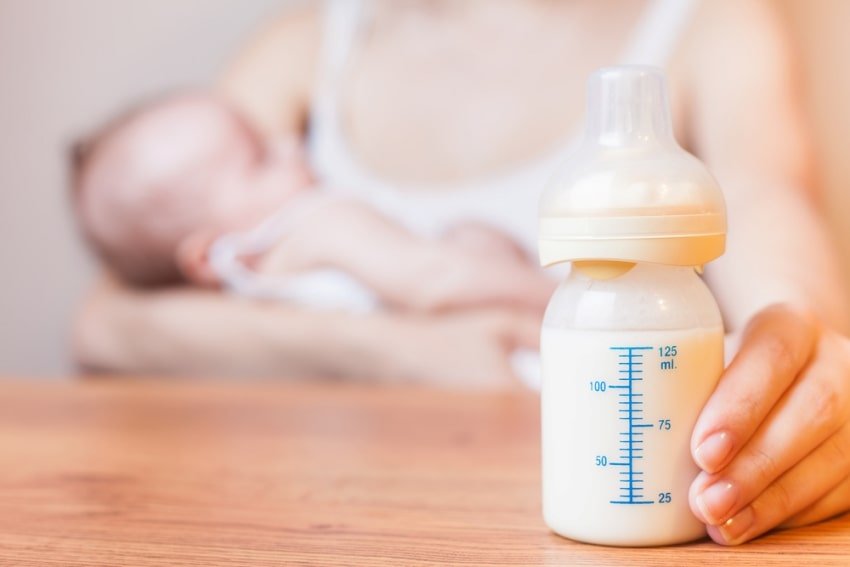Some parents have a hard time breastfeeding in the beginning. Out of a desire to nourish your little one, you might wind up giving them a bottle.
However, that nagging thought of whether you can still breastfeed and give your baby all the benefits of breastfeeding persists.
If this sounds familiar, you can take comfort in knowing that it’s never too late to start breastfeeding! Even if your baby is a few months old, you can still breastfeed.
In this article
How To Get Your Baby Used To Breastmilk
If your little one was given a bottle in the beginning, their first taste was of formula. It can be hard for little ones to make the switch from formula to breastmilk.
However, that doesn’t mean that it’s a lost cause. There are a lot of things that you can do to get your little one adjusted so that they will be happily breastfeeding.
Pump Out The Colostrum
Colostrum is what comes in before your breast produces milk. It’s packed with vitamins and nutrients to repair cells, boost the immune system, and help your little one grow and develop.
While this is great for babies, not all of them like it. This is a different color and a different flavor.
It tastes significantly different from breast milk and formula, which will instantly make babies spit it back out if they are used to the sweet taste of formula.
To help your little one adjust to breastfeeding, consider pumping out the colostrum. You can give your baby small amounts of colostrum in their bottle too!
This gives them more of the benefits of colostrum than not drinking any. Once you’ve pumped out the colostrum, your breasts will slowly start to produce milk.
At six weeks, you’ll still have small amounts of colostrum in your breast milk, but the amount is so small that most infants won’t notice that it is there.
It typically only takes 3-4 days for your breasts to start producing mature milk in place of just producing colostrum.
Try Breastmilk In A Bottle
View in gallery
Some babies have a hard time latching on. If they’ve already gotten used to a bottle or had a bottle right after being born, consider pumping breastmilk and putting it in a bottle.
Some little ones might not like breastfeeding, but they might not object to breastmilk. Use the same bottle and nipple that you usually do, but breastmilk in place of formula.
Keep in mind that it’s normal for babies to reject this because it’s different than what they had before. Some babies will not reject it, though, so it’s worth a try.
Gradually Add Breastmilk To Formula
If your little one flat out refuses breastmilk, they need to get used to the taste. In this case, you’ll need to slowly add breastmilk to the formula. This will help your little one adjust to drinking breastmilk in place of formula.
Begin by adding one ounce of breastmilk. If your baby refuses, add a little less. If they do not, continue to add just one ounce to their bottles for the next 2-3 days.
Then, gradually increase the amount of breast milk that you add until your baby is drinking a full bottle of breast milk. Keep in mind that this process is different for each baby.
Some will quickly adjust to breastmilk, and others might take a little longer. Both ends of the spectrum are perfectly normal.
What If You Don’t Have Breastmilk?
Even if your body is not producing breastmilk, you can still breastfeed. Adoptive mothers that would like to breastfeed their children often begin the lactation process in order to feed their babies breastmilk.
Some mothers that give up on breastfeeding and then decide to go back to it also go through a similar process. It does take time and effort, but with a little bit of dedication, it’s more than possible.
Tips To Help You Start Breastfeeding
Producing milk is not enough to help your little one breastfeed. Likewise, making sure that your baby is comfortable breastfeeding is also not enough.
Instead, you’ll need to accomplish both. These tips and tricks will help both you and your little one work towards breastfeeding together.
View in gallery
Learn How Breastmilk Is Produced
Our body does begin to produce breastmilk when we are pregnant, but it is not the pregnancy that makes us produce breastmilk.
When we are pregnant, our body begins to produce a hormone called prolactin. This prolactin is what stimulates the body to produce breastmilk.
Other things can also make your body produce more prolactin. For example, nipple stimulation will make the body produce this hormone too.
If there is a lot of breast or nipple stimulation, some women can begin to produce breastmilk even if they do not have children.
Usually, this is in a sexual way, but those that are trying to learn how to make their body produce breastmilk so that they can breastfeed can learn from that.
Understand Relactation vs. Induced Lactation
These are two terms that you’ll come across a lot, so it’s important to understand the difference between them. Relactation is when a person stops breastfeeding and then starts again.
Induced lactation is a term that refers to when a person has not previously breastfed, yet they induce lactation. Both situations usually call for the same things, but induced lactation may take a bit more time.
Skin To Skin Contact Is Important
Skin to skin contact is important for mothers and their children, but it’s especially important if you plan to start breastfeeding.
This will help your baby get used to being very close to you while feeding. Younger babies will begin to search for your breast when they are hungry. This is a great way to encourage breastfeeding.
Work With A Lactation Expert
Working with a lactation expert is an exceptional idea! Lactation experts can help you build a plan to reach your lactation goals. Most have worked with mothers that need to induce lactation, learn more about re-lactation, and more.
Lactation experts can usually help with everything from proper latching techniques to teaching you comfortable ways to hold your little one while they breastfeed.
Consider Taking Hormones
Taking hormones can trick your body into thinking that you gave birth, even though you didn’t just have a baby. These hormones can make your body slowly begin producing breast milk.
Keep in mind that it might take time to have a milk supply that is large enough to keep up with your baby if they are more than a few days old. (That’s normal. Just remember that it takes time and patience.)
Stimulate Your Breasts And Nipples
Stimulating your breasts and nipples makes the body produce prolactin on its own. This can be done using a relaxing breast massage.
While this will help your body create more prolactin, it is usually only used as an extra tool to help you. It can take a lot of massage over an extended period of time to make you produce milk.
Another great way to stimulate your breasts and nipples is by using a breast pump. Consider this in addition to other methods.
Take A Lactation Support Supplement
There are tons of lactation support supplements on the market that are geared towards boosting your milk supply.
These can not only help you begin to produce breastmilk sooner, but they can also help you increase your milk supply once it comes in.
- Our Lactation Supplement contains folic acid, vitamin D3, and calcium, to ensure youre milk is enhanced with all the essential nutrients your baby needs.
- Premamas Breastfeeding Supplement is specially formulated with fenugreek, fennel seed, and blessed thistle. Herbs that increase milk production and have been used for generations to support breast milk supply.
- Premama’s Lactation support drink mix comes in convenient individual sachets that you take with you on the go.
Prices pulled from the Amazon Product Advertising API on:
Product prices and availability are accurate as of the date/time indicated and are subject to change. Any price and availability information displayed on [relevant Amazon Site(s), as applicable] at the time of purchase will apply to the purchase of this product.
Have Patience
Tips and tricks will help you develop your milk supply, but it can take some time. Most parents will find that it takes approximately 6-8 weeks for their full milk supply to come in.
It can get tiresome massaging your breasts several times a day for weeks on end, but it’s important to have patience during this process. Remembering that it will take a month or two will help you have the patience that you need.
Expect Significant Breast Changes
As your milk supply comes in, you’re going to notice changes in your breasts. Make sure that you’re mentally prepared for these changes so that you won’t be caught off guard.
Your breasts and nipples may be sore. Breasts will typically grow by at least one cup size, so picking up a few new bras is a great idea.
Breastfeeding bras are recommended, but some moms prefer the look of cute bralettes that are both stretchy and stylish. You can also expect your breasts to leak a little bit. While this doesn’t always happen, it’s best to be prepared in case it does.
In Conclusion
It’s never too late to start breastfeeding! Some moms give their child a bottle, but then regret their decision and wind up breastfeeding when their baby is six months old.
Even adoptive mothers can breastfeed! Don’t lose hope, and seek help if you need it. Lactation experts are wonderful!






